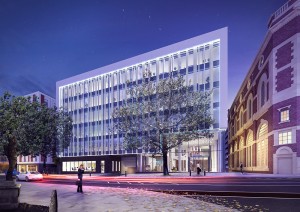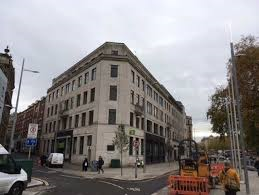Bristol’s industrial property sector is enjoying its most significant speculative industrial building period ever while its buoyant city centre office market is about to achieve another record rent.
According to a number of recent reports on the city’s commercial property market, Bristol is increasingly competing against larger UK cities such as Manchester and Birmingham for investment and levels of activity. 
The latest twice-yearly Market Monitor report by South West property agents Alder King reveals that Aurora, pictured, the city’s only speculative office development, has a deal in solicitors’ hands that will set a new record rent of £34 per sq ft.
The highest rent paid in the city centre is currently £32.50 achieved with a previous letting at Aurora and at the extensively refurbished One Cathedral Square let to Dyson and the University of Bristol.
Aurora, with 95,500 sq ft of Grade A space, is Bristol’s only speculative office development and is now 80% pre-let as it nears completion.
With no other speculative offices being built in Bristol city centre at present, property agents are warning of a severe shortage of the type of prime space suitable for expanding professional services firms.
Alder King partner Simon Price said: “Take-up in the first half was subdued, largely due to a lack of supply rather than a lack of inquiries. Some significant deals are now in solicitors’ hands.
“There is a severe shortage of new or newly refurbished Grade A accommodation in the city centre and out of town markets. In addition the lack of Grade B space in the city centre is impacting on the grow-on market.”
Bristol Office Agent’s Society recently announced a strong start to the year for the city centre and out-of-town office markets with take-up for the first six month’s totaling a 438,817 sq ft.
Demand was subdued in the first quarter of the year, but strong levels of take-up returned for the second quarter of the year, it said.
The largest city centre deal in the first half was magazine publisher Immediate Media’s acquisition of 34,612 sq ft at Trilium’s Eagle House on Colston Avenue. The building, pictured, is to be comprehensively refurbished to provide high-quality space with the potential for a further 3,600 sq ft penthouse suite to be added with a new fifth floor.
Knight Frank office agency partner and chairman of the South West OAS, Martin Booth, said: “The shortfall in office supply will not be rectified any time soon. The popularity of Bristol to inward investors – and the increase in employment opportunities generated – is great to see, but this added demand only highlights the supply shortages the city will have going forward.”
Lambert Smith Hampton office agency director Peter Musgrove, who is also head of its Bristol office, added: “Take-up so far for the year is a reflection of supply issues rather than demand. We continue to have good levels of requirement across all sectors, especially TMT, but availability, especially of Grade A space, is lagging. Due to this we expect to see more deals akin to Immediate Media’s and a return to pre-lets.”
Meanwhile developers and investors are responding to buoyant industrial demand and to the city gearing up for fundamental changes in the way the supply chain functions, said Russell Crofts, head of the industry & logistics division at property consultancy Knight Frank in Bristol.
Russell, pictured, said: “We have seen over 4m sq ft of industrial and warehouse development throughout the city since 2016, but this has mainly been undertaken by occupiers for their own use – most notably Amazon, the Range and Lidl.
“Now investors and developers have been buoyed by this demand and are speculatively developing units for the next wave of growth throughout the city.”
The last significant trend of this nature was in 2000/2001 when some 600,000 sq ft was built throughout the city in 14 new industrial estates.
“Move forward to 2018 and Bristol is seeing unprecedented development of approximately 1.5m sq ft in 10 different schemes. Where this is different from the last few years is that all sizes from 6,000 sq ft to 150,000sq ft are being built in all locations from North to South, and East to West,” Russell said.
“We are witnessing structural change on a UK-wide scale, as occupiers gear up to meet the new demands of “just-in-time” industry and the same day delivery consumer. Proximity to distribution networks and to the chimneys pots of the consumer has created demand for ‘urban logistics’ from occupiers.
“Investors have seen this development throughout all UK markets and are now gearing up to provide the properties that will provide the infrastructure of the future.
“Behind this first wave of development is another 700,000 sq ft of development planned over the next two to three years. This will ensure that Bristol is fit for purpose as the economy re-focusses on an internet-driven world. In context, this total supply represents approximately 12 months’ worth of total take up in the city.”






























